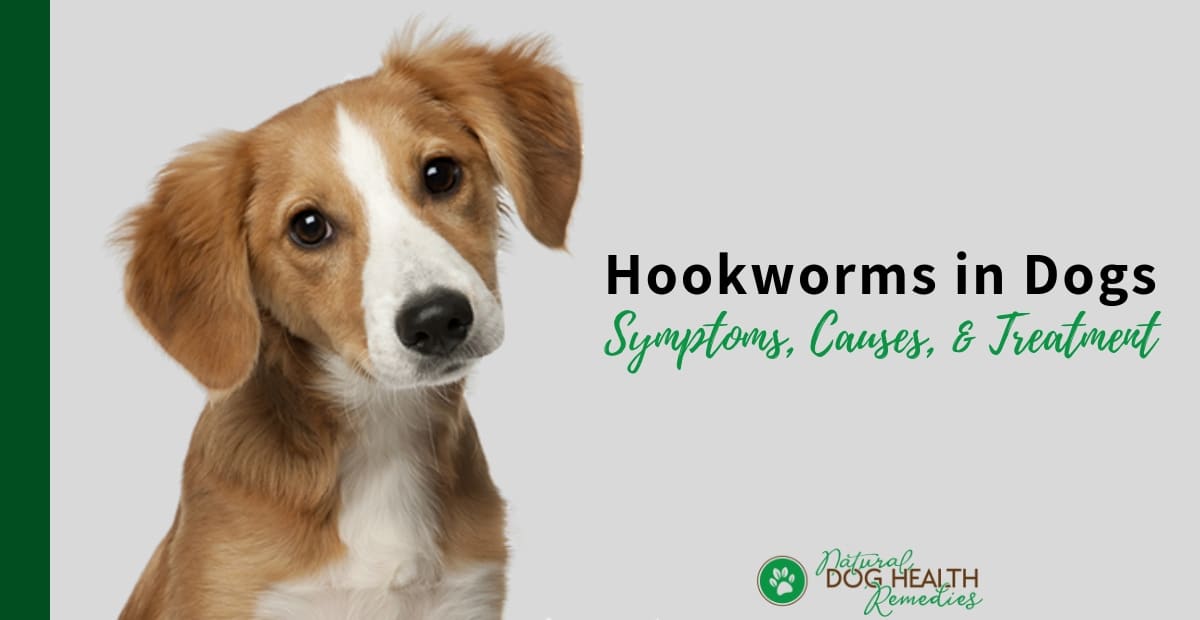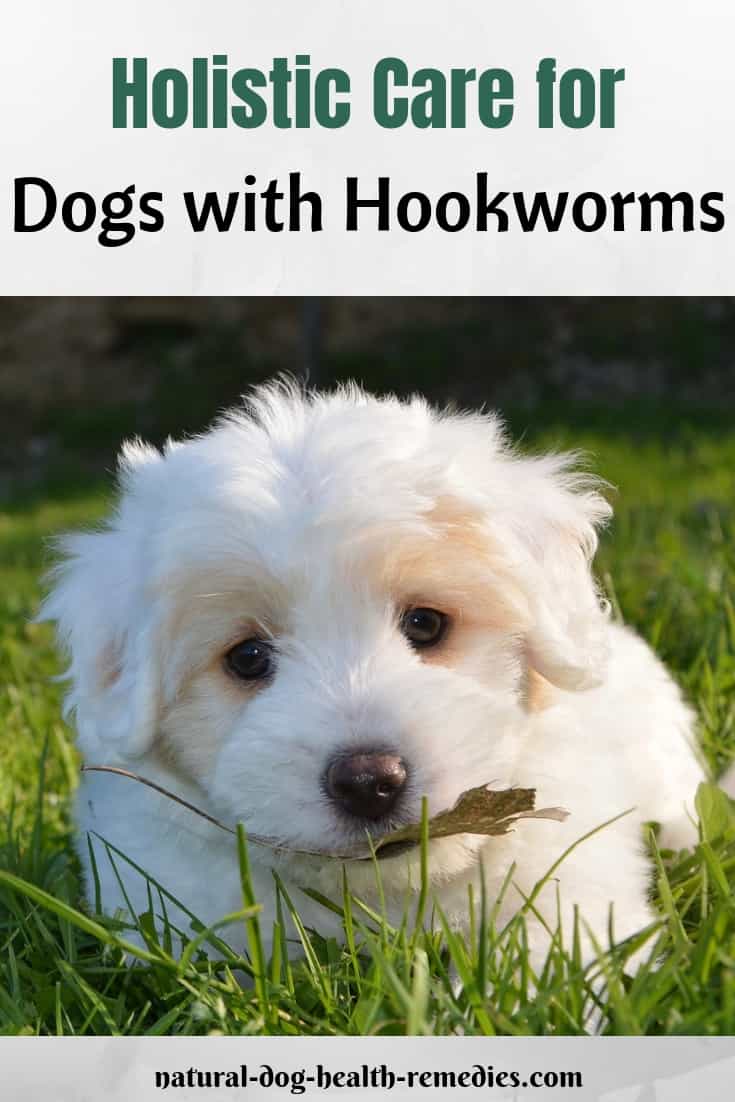Eliminate Hookworms in Dogs
(FTC Disclosure: If you make a purchase via a link on this page, I may receive a small commission, at no added cost to you.)

Overview
The hookworm (Ancylostoma and Uncinaria) is a common intestinal parasite of dogs, especially among young puppies.
Unlike roundworms that just float in the dog's intestines, hookworms actually have "teeth". They use these "teeth" to attach themselves to the dog's intestinal wall.
Since they live on the host's blood, hookworms in dogs can cause anemia, as well as other problems such as serious diarrhea.
Life Cycle of Hookworms
Hookworms are rather small (up to 1 inch in length) and thread-like.
Their life cycle begins with adult worms within a dog's intestine laying eggs, which are ejected into the dog's digestive tract and pass into the environment through feces.
If the environment is favorable (warm and humid), the eggs hatch into larvae which then search for a host.
How Do Hookworms Infect Our Dogs?
Dogs can get infected with hookworms in a number of ways:
1. Ingestion of LarvaeLarvae may be ingested through contaminated food, water or soil.
Once ingested, most larvae migrate to the intestine where they mature into adults and remain. Like roundworms, some larvae may decide to stop their migration for a while and encyst in muscles, fat, or other tissues.
2. Skin PenetrationLarvae can also gain entry to a dog's body through the skin (usually the footpads).
Once inside the body, the larvae travel to the lungs and trachea via the bloodstream.
While in the respiratory system, they cause irritation and coughing in the dog. The larvae are coughed up and re-swallowed. Then they migrate all the way down to the intestine where they attach themselves to the intestinal wall and grow into adults.
3. In-utero TransmissionHookworm larvaes can become encysted and take up residence in a bitch's uterus. There they infect unborn puppies through their placentae.
Once inside a fetal puppy, the larvae move to the puppy's lungs and live there until the puppy is born.
When a puppy infested with hookworm larvae is born, the lungs are filled with larvae which irritate the puppy.
The puppy will then cough up the larvae which are re-swallowed back inside its digestive system, where the larvae will mature into adult worms.
4. Transmission while NursingNot only can the hookworm larvae live in a dog's uterus, they can also migrate to the mammary gland of a mother dog, thus infecting puppies while they are being nursed. The swallowed larvae then migrate to the puppy's digestive system where they mature in the intestine.
Symptoms of Hookworms in Dogs
 Because hookworms feed on the dog's blood, they cause excessive blood loss resulting in anemia in the dog.
Because hookworms feed on the dog's blood, they cause excessive blood loss resulting in anemia in the dog.
An infected dog will show the following symptoms:
- Pale mucous membranes, e.g. pale gums
- Lethargy
- Black, tarry stools
- Dull hair coat
- Stunted growth in puppies
- Diarrhea
- Vomiting
If skin penetration has taken place, the footpads or other areas may:
- appear red
- bleed
- itch
- become infected
In severe cases, the dog may cough and/or develop pneumonia as the larvae get to the lungs via the bloodstream. This may be fatal to the dog.
Diagnosis of Hookworms in Dogs
Diagnosis is by using a microscope to look for eggs in a stool sample.
Very young puppies can start to show signs and symptoms of hookworm infestation even before the adult worms have started to lay eggs. As such, worm eggs may not be detected in a fecal examination. In such cases, diagnosis is made based on clinical signs.
Compared to roundworms, the adult hookworms are relatively small and are difficult to be detected in the stool.
How To Get Rid of Hookworms in Dogs
As hookworms can cause serious health problems in dogs such as anemia, it is important to eradicate the worms without delay.
The best course of action is for dogs, especially puppies, to receive conventional deworming treatment under veterinary supervision.
Common dewormers include fenbendazole and moxidectin. These are given orally but they only kill the adult worms.
It is therefore important to treat the dog again in 2 to 4 weeks to kill off newly grown adult hookworms that were larvae during the first treatment.
Fenbendazole is considered safe and have few side effects. In some dogs, they do experience mild side effects such as diarrhea, vomiting, hives, appetite loss, and lethargy.
Moxidectin should not be used with herding dog breeds (e.g. Border collies, Old English sheepdogs, etc.) as genetically they are extremely sensitive to the drug.
Holistic After Care
Read the section on "After Care" on our "dog worms" page to see how to provide holistic care to dogs after deworming.
In addition, dogs with hookworms usually suffer from anemia. Therefore, blood-building supplements rich in iron and vitamins should be given to provide the dogs' bodies with the necessary building blocks for new blood to be produced.

A Great Natural Product
This supplement is designed to help improve the health of blood and the blood forming organs (i.e. the spleen, liver, bone marrow, and kidneys). It contains ingredients rich in RNA/DNA, iron and vitamin B12, which are essential for the formation of hemoglobin.
Preventing Your Dog From Getting Hookworms
As hookworms can wreak havoc to a dog's health, it is important that to prevent your dog from getting the worm in the first place. Here are a couple of things you can do:
SanitationThe larvae of hookworms can survive in cool, moist soil for several weeks, but die rapidly in freezing or hot, dry conditions. Yards and kennels should be cleaned daily. All fecal material should be collected and removed daily.
Deworming Female Dogs during PregnancySo that female dogs cannot infect their own puppies with hookworms, it is essential that a pregnant dog be given a special deworming treatment by a veterinarian.
They should also receive another deworming treatment after giving birth, at the same time as the puppies are being dewormed (at around 2 to 3 weeks old).
Can A Person Get Hookworms from a Dog?
While the adult hookworm cannot infect people, some hookworm larvae have the ability to penetrate human skin, causing severe itching and dermatitis. This condition is known as "creeping eruption" or "ground itch".
In rare cases, the larvae can migrate to a person's eyes and other organs, causing complications such as blindness.
Since hookworm larvae thrive in warm sandy soils, avoid walking barefoot through the sand, and don't allow your dog to poop on the beach!
ReferencesEldredge, et al. Dog Owner's Home Veterinary Handbook 4th edition (Wiley Publishing, 2007).
C.J. Puotinen, Natural Remedies for Dogs and Cats (Keats Publishing, 1999).
M.L. Wulff-Tilford and G.L. Tilford, Herbs for Pets (Bowtie Press, 1999).
R.H. Pitcairn, The Complete Guide to Natural Health for Dogs and Cats (Rodale, 2005).





